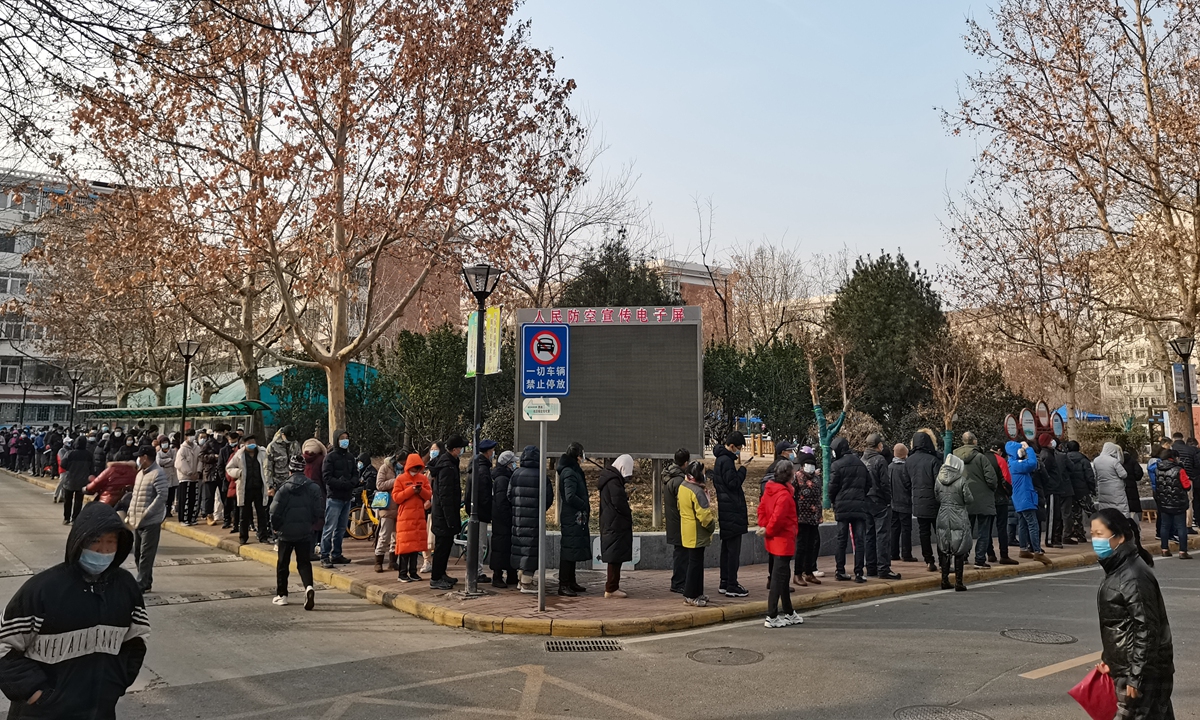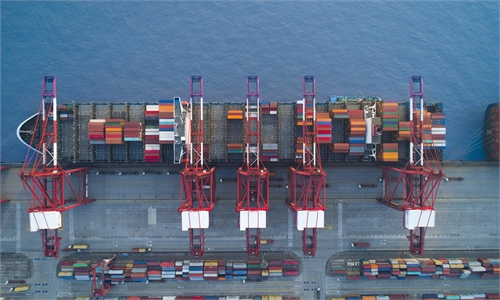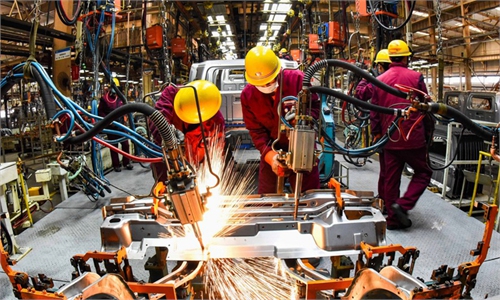COMMENTS / EXPERT ASSESSMENT
New COVID-19 flare-ups test China’s economic recovery in 2022

Residents line up to undergo nucleic acid testing in a residential compound in Tianjin's Nankai district on January 9, 2022. Photo: VCG
Concerns, genuine or otherwise, were already growing over the downward pressure of the Chinese economy in 2022, then a new severe wave of COVID-19 infections in several major cities, including the spread of the more transmissible Omicron variant, sparked a new wave of concern for the world's second-largest economy.On Monday, the Chinese mainland reported a total of 157 new COVID-19 cases, of which 97 were locally transmitted infections. The majority of cases were in Central China's Henan Province with 60 cases. North China's Tianjin, which became the first Chinese city to experience the Omicron variant, reported 21 cases after a round of mass testing. Northwest China's Shaanxi Province, which has been fighting what many describe as the most severe outbreak in China since early 2020, reported 15 cases. Shenzhen in South China's Guangdong reported one case.
From a public health standpoint, the number of cases remains low, in comparison to many countries around the world. The US, for instance, is averaging over 700,000 new COVID-19 cases per day, driven largely by the Omicron variant, according to US Today. In China, even though there were ominous signs of the Omicron variant making its way out of Tianjin and into Henan, there is no public panic about the health situation, thanks to China's proven ability to control cases and deaths. China has reported a total of 4,636 deaths since the outbreak of the COVID-19, whereas the US has seen a total of over 837,000 deaths.
The growing worry is about the impact of the new outbreaks on China's economic recovery in 2022. While the world's second-largest economy mounted a world-leading recovery over the past two years, there are growing concerns over growth prospects this year due to a series of downside risks and challenges. Chinese policymakers are also fully aware of the difficulties, as the tone-setting Central Economic Work Conference in December concluded that the Chinese economy continues to face shrinking demand, supply disruptions and softening expectations.
Given the recent outbreaks, COVID-19 poses the biggest risk for the Chinese economy in 2022. For example, the latest flare-ups in Shaanxi, Tianjin and Henan resulted in disruptions to economic activities, as local authorities take strict anti-epidemic prevention and control measures, despite efforts to minimize the overall economic impact.
For example, businesses in Xi'an, Shaanxi, including foreign giants including Samsung, were able to continue operations with various measures in place, but some degree of impact on economic activity cannot be avoided. The impact on small businesses, including restaurants, hotels and small shops, is difficult to avoid under strict anti-epidemic measures.
That means, based on the cases reported on Monday, the latest COVID-19 outbreaks are affecting numerous businesses in the three places - Henan, Shaanxi and Tianjin - the fifth, 14th and 23rd largest provincial-level economies in China, with a combined GDP of 9.5 trillion yuan ($1.5 trillion). Moreover, various localities, including Beijing and Guangdong, have also tightened anti-epidemic measures ahead of the Chinese New Year and the upcoming Winter Olympic Games.
In light of these strict measures, including official remain-in-place guidance for the Chinese New Year, the busiest holiday travel peak in China, there has been growing discussion about the impact of the epidemic control measures on the Chinese economy. In particular, there are genuine concerns among small business owners. And there is a widespread expectation that China's economic growth will slow down significantly in 2022, with some foreign media outlets and institutions forecasting the slowest GDP growth in China in decades.
China's dynamic zero-case approach against COVID-19 has been remarkably successful in protecting public health and ensuring economic recovery, still some foreign media outlets have stepped up attacks against the policy, citing the economic costs. This kind of slander is ill-intentioned and grossly out of context.
However, how to keep the virus at bay fast, while minimizing the impact on the economy is a real test in 2022, amid the still raging pandemic and already acute downward economic pressure. It is paramount that China passes this test not just for the domestic economy but also for the global system.
The author is an editor at the Global Times. bizopinion@globaltimes.com.cn




